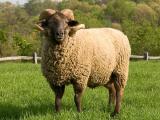
|
Hampshire SheepThe Hampshire sheep acquired its name from the agricultural county of Hampshire in southern England where it was developed from Old Hampshire, Southdown, Wiltshire Horn, and Berkshire Knot crosses. Hampshires were first brought to the United States in 1860, but all of the flocks were either destroyed or scattered during the Civil War. |

|
Han SheepThe Han is a type of Mongolian sheep. It was developed in the semi-humid agricultural areas of China (Henan, Hebei, Shandong, Anhui and Jiangsu Provinces). There are two types of Han which in 1982, were claimed as two different breeds: Large-tail Han and Small-tail Han. The Large-tail Han are polled and are characterized by a long, broad, fat tail, with a thin twisted end turing upwards between two lobes, and broadest at the base. Maximum weight being 25 kg. |

|
Hebridean SheepThe Hebridean, a sheep breed now classified as rare, originated in the islands off the western coast of Scotland. They are classified as one of the Northern Short-tailed breeds. Over the centuries, Hebridean ewes have been selected by natural systems for hardiness in all weathers, ease of lambing, milkiness and good mothering instincts. |

|
Heidschnucke SheepThe Heidschnucke are a fairly small sheep, initially originating from Niedersachsen in Germany. There are several varieties of Heidschnucke sheep: the grey horned Heidschnucke, the white horned Heidschnucke, and the moorschnucke (marsh sheep). At one time, the Heidschnucke were the most important sheep in northern Germany, but their numbers have declined substantially. |

|
Herdwick SheepThey name Herwick is derived from an old Norse word that means sheep pasture. It is believed that the ancestors of Herdwick sheep were introduced by early Norse settlers. Herdwick sheep are considered the most hardy of British hill sheep. |

|
Hill Radnor SheepThe Hill Radnor is a hardy hill sheep with a long history attached to the central marshes of Wales. |

|
Hog Island SheepAbout 200 years ago, a flock of sheep was established on Hog Island, one of Virginia's barrier islands located off its Eastern Shore. The sheep were already native to the area and are believed to have had a substantial amount of Merino blood in them. There were occasional subsequent introductions to the population, the last being in 1953, when a Hampshire ram was taken to the island. In 1974, the island was sold to The Nature Conservancy, which decided to remove all the sheep and cattle. |

|
Hu SheepHu sheep originated from Mongolian sheep. They are distributed in the Zhejiang Jiangsu provinces of China and the suburbs of Shanghai. Hu sheep are well recognized for their beautiful wavy lambskins, early sexual maturity, aseasonal breeding, prolificacy, and the adaptability to a hot and humid climate. Hu sheep are raised indoors all year round. The lambskins taken from lambs slaughtered within the day of birth have distinctive wave-like stripes which are still retained after processing. |